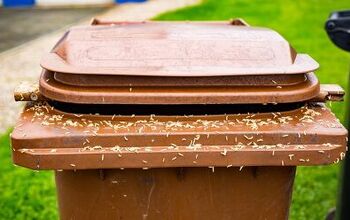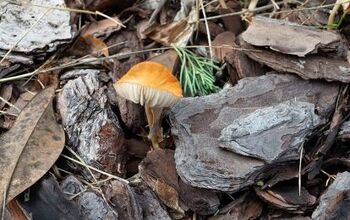How to Get Rid of Hoverflies (Step By Step Guide)

Hoverflies are pesky little insects that love your garden as much as you. While they’re necessary for the ecosystem, they can still be a nuisance. This is especially true if they occupy your home.
Mix 2 ounces of vinegar with 12 ounces of water and 1 tablespoon of dish soap in a bottle. Spray the nest or the area where you often find the hoverflies with the solution to keep them away. You can also mix 10 drops of lavender, 15 drops of eucalyptus, and 15 ounces of water and spray the hoverflies or their nest.
You need to discover the best method for you. Hoverflies do not bite or sting. They’re not hazardous to your plants. They pollinate your plants and get rid of other pests for you.
However, if they are in your home or on your porch, they need to be removed. We will share several steps with you to help you get rid of the hoverflies that are invading your space.
Do You Need Pest Control Services?
Get free, zero-commitment quotes from pro contractors near you.

What Are Hoverflies?
Hoverflies, also known as the flower fly, or syrphid fly, are insects that have a resemblance to wasps. In fact, they are often mistaken for their more dangerous counterparts due to their black and striped yellow bodies. They are nicknamed flower flies because they feed on the nectar and pollen from flowers, among other foods.
Although they don’t pose any harm to you or your garden, when they are present in large quantities, they can make it difficult to enjoy flowers. They often mimic the patterns of yellowjackets, bees, and wasps as a natural defense against their predators. Unfortunately, this makes them an easy target for gardeners who think they are deadly pests.
When a hoverfly lays larva on a leaf, the larvae eat the aphids. The worms are incredibly beneficial in pest control. These flies may land on a human to lick the salt from their skin, but they do not bite.
Identifying Hoverflies
As previously stated, adult hoverflies resemble bees or wasps. They are commonly seen visiting flowers or hovering over them – hence their name. Though, there are many different species of hoverflies, ranging in size from less than ¼ inch long to more than ¾ inch long.
Many sport the conventional black and yellow stripes on their abdomen, which give them their bee-like appearance. Other species are hairy with a long, thin abdomen. Regardless, all hoverflies have short antennae.
There are a number of different ways you can distinguish hoverflies from bees, wasps, yellow jackets, and other insects. Aside from their stubby antenna, hoverflies are characterized by their large eyes, fat, broad waists, halters, and lack of a stinger.
What are Hoverflies Attracted To?
Adult hoverflies feed on the nectar and pollen from flowers. The larvae usually feeds on organic debris, and there are even some species of hoverflies that eat aphids.
As such, hoverflies are often drawn to mixed garden plantings and weedy borders that are infested with aphids. Wild mustard, dill, coriander, sweet alyssum, wild carrot, or Queen Anne’s lace are the most appealing flowers for hoverflies, as well as a number of other small-flowered herbs.
How to Get Hoverflies Off of Your Porch and Out of Your Home
Sometimes hoverflies will make a home right on your porch. It’s annoying to walk out into the middle of their swarm. Although, since they’re not inside your house, try to repel them without killing them.
Option 1: Use a High-Powered Fan
- Set an oscillating fan facing the swarm of flies. Make sure that the fan is centered directly at the hoverflies. If you don’t have an oscillating fan, a regular one will work just fine.
- Turn the power on high and leave it on for 8 to 12 hours. This will encourage them to move from your porch to another location.
- If you turn it off and they return, keep the fan blowing for a few days.
An oscillating fan is ideal because it spreads the wind further. So, if the hoverflies move, this fan will move with them.
Option 2: Create Your Own Repellent
You can create your own repellent and use this along with the fan method. There are several repellants you can create, all of which are non-toxic.
Soap, Water, and Vinegar
- Fill a 16 oz spray bottle 3/4 of the way with water.
- Add 2 ounces of vinegar. (This can be white vinegar or apple cider vinegar)
- Include one tablespoon of Dawn dish soap
- Swirl the ingredients together, do not shake.
Aim the mixture at the nest and spray until it is thoroughly soaked. The files will not return to their nest, thus leaving your porch.
Eucalyptus Oil or Lavender Oil
You can use either eucalyptus oil or lavender oil. You can also mix these both for the best effect.
- Fill a 16 oz bottle with 15 oz of water.
- Use 25 drops of either eucalyptus or lavender.
- If you want to combine, use 15 drops of eucalyptus and ten drops of lavender
- Spray the nest of the hoverflies until it is thoroughly soaked.
This method will have the same effect as the soap, water, and vinegar method. The flies will not return.
Citronella
Citronella is available in both oil and smoke.
To Use The Oil:
- Mix 25 drops of citronella oil with 15 oz water in a 16 oz water bottle
- Shake the mixture
- Soak the next with the citronella oil and water
To Use The Smoke:
- Use either citronella incense sticks or a candle.
- Place the product under the nest where the hoverflies live.
- Light the stick, or candle, and leave it to burn
- Make sure you do not leave the stick or candle unattended too long.
The smoke should encourage the flies to find another home.
Fruit Or Fruit Peels
While this method will not repel them, it will attract them to another area.
- Find a large container and place the peels in the bottom.
- Sprinkle 1 tsp of sugar and 2 tbsp of water.
- Mix the peels with the sugar
- Set the container near your garden to draw the flies away from your porch
- For this method to work, you should also spray their nest with any of the mixtures, as mentioned above.
Option 3: For Your Porch and Inside of Your Home
Since hoverflies are beneficial to your garden, you want to try and avoid killing them. Although, that is not always possible. In case you cannot get them to leave, you have some last-resort options.
Glue Ribbon
The glue ribbon will trap the fly as soon as it touches it. Once the trip is full, you simply remove and throw away
To set up the glue ribbon:
- Slowly unravel the glue ribbon
- Wrap the red string around the tack, and push the nail into the ceiling.
- Set at least 3 to 4 ribbons six feet apart
- Wait for a few days, and remove the ribbon to discard
Electric Fly Swatter
Most of these traps rely on a fly landing on them. In the case that they don’t, you can purchase an electric fly swatter. The electric fly swatter is a racket-style swatter with an electrical grid placed in the circular area.
- Press and hold the button with your thumb
- Swat the hoverflies that are swarming your patio, or your home.
- Sweep up the dead flies
The electric swatter will kill on contact. You just have to be quick.
Fly Bucket
You can purchase a fly bucket to use as well. To use this:
- Place the bucket below the area where you have the hoverfly issue
- Set bait at the bottom. This can be fruit peels or flowers.
- Place the lid on it, and the flies will crawl in and get trapped.
- Find a place you want to release the flies. This can be your garden, or you could call up a friend who may want them for their garden.
Trap and Toss
You can purchase a trap and toss fly trap from Home Depot, Lowes, or even Walmart.
- Follow the instructions on the back since all buckets have different ways of operating.
- Place the bucket under the nest of your hoverflies. If you are using this indoors, place it under the swarm of hoverflies.
- The bucket has poison in it to attract and kill the flies.
- Once your flies are gone, toss the bucket in the trash.
Now, if you only have a couple of flies in your home, your best bet will be the electric fly swatter.
Zapper (Outdoor Use Only)
A zapper is used to kill a lot more than just flies. This will help with gnats, mosquitos, and moths as well.
- Place the zapper near your porch light. All bugs are attracted to light. Therefore, they will fly into the zapper.
- Keep it out of reach of children and pets.
- Follow the safety precautions on the package.
You can use several of these methods together for the best effect.
Why You Should Consider Keeping Hoverflies Around
Aside from controlling 70% to 80% of the aphid population, they also take care of other soft-bodied insects. They are almost as effective as ladybugs and lacewings at controlling aphids.
Flower flies also pollinate flowers and crops. Without pollination, the plant will not produce the seeds you need. Many people will plant individual flowers to attract them to their gardens.
Some of the flowers or herbs that people plant to attract hoverflies are:
- Sweet Alyssum
- Bachelor Buttons
- Buckwheat
- Catnip
- Oregano
- Garlic Chives
- And a slew of other herbs.
Many gardeners see them as beneficial rather than pesky. Although, if they come onto your patio or in your home, that may be an issue.
How to Keep Hoverflies Out of Your Garden
Now, if you do not want them in your garden, there are a few things that you can do:
- Do not plant the flowers or herbs that attract them.
- Spray your plants with peppermint oil
- Spray your plants and flowers with plant-safe insecticide
- Install a zapping lamp nearby
It’s almost impossible to rid them from your garden. However, you can cut down on their population if you wish. The above methods will help you successfully do that.
Related Questions
Why are hoverflies in my house?
Hoverflies are not generally home infesting pests. They live outdoors; so, when they are found indoors this is usually a mistake and they will not live for long.
How long do Hoverflies stay?
How long hoverflies will linger around your garden will depend on their lifespan, which varies based on the specific species. Generally speaking, most adult hoverflies live for 12 days on average. Though, the ‘Hammerschmidtia ferruginea’ was discovered to live for up to 55 days!
Are hoverflies dangerous?
No, hoverflies are not bad. Even though they are a nuisance at times, they cannot harm you. Hoverflies are not like other flies. This particular breed of the fly is a benefit to gardeners, as they pollinate their flowers and crops.
Are hoverflies friendly?
Yes, hoverflies are friendly. Although, they will pretend they are wasps to ward off their predators. While they have similar characteristics to a wasp, they do not sting or bite. They will not attack you.Think of them as bees without the ability to sting or bite. They are entirely harmless to your garden, pets, and other humans. They are often mistaken as wasps. Except, wasps are a lot larger and more aggressive. The hoverfly is shorter and does not have a stinger sticking from the end.
Do You Need Pest Control Services?
Get free, zero-commitment quotes from pro contractors near you.

Final Thoughts
Whether they’ve moved to your porch or helped themselves to your home, they’re easy to remove. For the best results, combine several of the removal methods.
Remember, they are not harmful to humans. If you have a garden, perhaps you could release them there. If not, call a friend who loves gardening and rehome them. Now you can enjoy your surroundings, hoverfly free.

Heather is a passionate writer who loves anything DIY. Growing up, she learned everything from home repairs to design, and wants to share her tips with you. When she's not writing, she's usually hiking or searching for her next DIY project.
More by Heather Robbins















![10 Most Dangerous Neighborhoods in Baltimore [Updated]](https://cdn-fastly.upgradedhome.com/media/2023/07/31/9075655/10-most-dangerous-neighborhoods-in-baltimore-updated.jpg?size=350x220)











